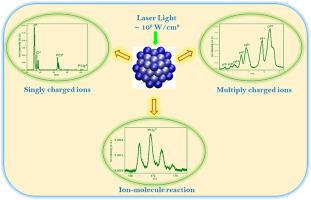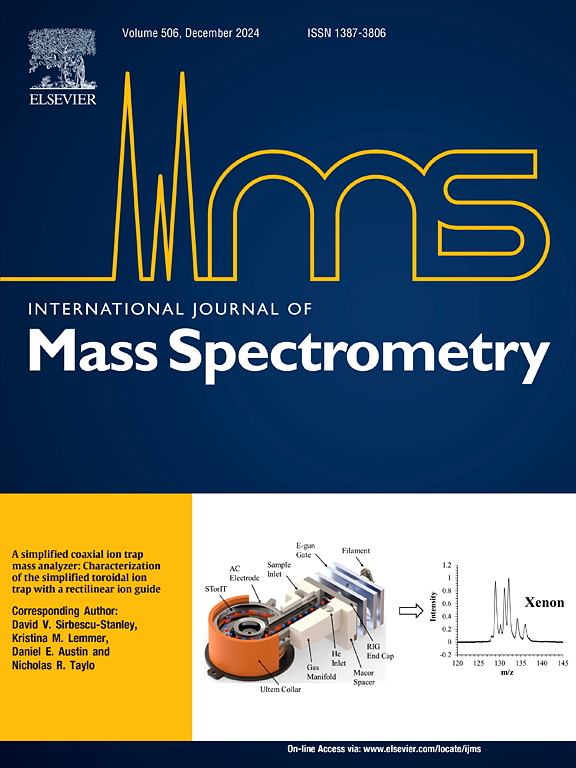Photoionization of phosphorous trichloride clusters at gigawatt intense laser field
IF 1.7
3区 化学
Q3 PHYSICS, ATOMIC, MOLECULAR & CHEMICAL
引用次数: 0
Abstract
Photoionization study of PCl3 clusters has been carried out using time-of-flight mass spectrometry at selected wavelengths of UV (266, 355 nm) and Visible (532 nm) region employing nanosecond laser pulses of intensity ∼109 W/cm2. At these three laser wavelengths, dissociated fragments such as P+, Cl+, PCl+ and PCl2+ are observed in the mass spectra. Formation of different fragments has been explained based on the multiphoton excitation at the respective wavelengths. Moreover, PCl4+ ions are observed in 266 and 355 nm ionization of PCl3 clusters. Generation of PCl4+ is explained based on ion-molecule reaction within the ionized cluster. Using density functional theory (DFT), structure, ionization energy and absorption spectra of PCl3 monomer and clusters have been calculated which helps to rationalize the experimental observation. Along with singly charged fragment ions, multiply charged atomic ions up to P5+ (I.E: 65.1 eV) and Cl4+ (I.E: 53.5 eV) are observed at 532 nm. Generation of multiply charged ions at such low laser intensity indicates efficient ionization of PCl3 clusters. Formation of higher charge states can be explained based on “multiphoton ionization ignited-inverse bremsstrahlung heating–electron ionization”. Detailed study reveals that laser intensity, cluster size and ionization energy of the cluster constituents play an important role in governing the ionization dynamics under gigawatt laser intensity conditions. Thus, PCl3 clusters exhibit diverse photochemical process as a function of laser wavelength at ∼109 W/cm2.

千兆瓦强激光场下三氯化磷团簇的光电离
利用飞行时间质谱技术,利用强度为~ 109 W/cm2的纳秒激光脉冲,在选定波长的紫外(266,355nm)和可见光(532nm)区域对PCl3簇进行了光电离研究。在这三个激光波长下,在质谱中观察到P+、Cl+、PCl+和PCl2+等解离碎片。基于各自波长的多光子激发,解释了不同碎片的形成。此外,PCl3簇在266 nm和355nm电离处均有PCl4+离子的存在。PCl4+的产生是基于电离团簇内的离子-分子反应。利用密度泛函理论(DFT)计算了PCl3单体和团簇的结构、电离能和吸收光谱,有助于实验观测的合理化。除了带单电荷的碎片离子外,在532 nm处还观察到P5+(即:65.1 eV)和Cl4+(即:53.5 eV)的多电荷原子离子。在如此低的激光强度下产生多重带电离子表明PCl3团簇的有效电离。高电荷态的形成可以用“多光子电离点燃-逆轫致加热-电子电离”来解释。详细研究表明,激光强度、团簇大小和团簇组分的电离能对吉瓦激光强度条件下的电离动力学起着重要的控制作用。因此,PCl3团簇表现出不同的光化学过程,作为激光波长在~ 109 W/cm2下的函数。
本文章由计算机程序翻译,如有差异,请以英文原文为准。
求助全文
约1分钟内获得全文
求助全文
来源期刊
CiteScore
3.60
自引率
5.60%
发文量
145
审稿时长
71 days
期刊介绍:
The journal invites papers that advance the field of mass spectrometry by exploring fundamental aspects of ion processes using both the experimental and theoretical approaches, developing new instrumentation and experimental strategies for chemical analysis using mass spectrometry, developing new computational strategies for data interpretation and integration, reporting new applications of mass spectrometry and hyphenated techniques in biology, chemistry, geology, and physics.
Papers, in which standard mass spectrometry techniques are used for analysis will not be considered.
IJMS publishes full-length articles, short communications, reviews, and feature articles including young scientist features.

 求助内容:
求助内容: 应助结果提醒方式:
应助结果提醒方式:


